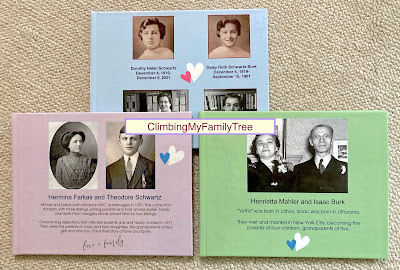This year I've been making a series of professional photo books as bite-sized family history projects, to be read, spark questions/conversations, and then saved for the future. Above, three from my family...two more are in the works for hubby's family.
Each of my photo books contains 20 pages, plus a glossy front and back cover. The front cover introduces the ancestors and how they are related to our family, plus a sentence or two to intrigue my readers. The covers are colorful and inviting to suggest a lively story inside.
This is just my approach--yours may be different, depending on your goals and your audience. My goal is to share family history in a conversational way, with affection and an insider's perspective so descendants get to know the people and understand a bit about family dynamics back in the day.
The interior can be expanded to many more pages but my readers (in the next generation and hopefully generations after that) don't need or want every last detail. If they want, they can take a look at my online trees to get every fact and review every document.
"Black and white is boring" according to my audience, so every page pops with color, whether it's colorful text, a bright frame surrounding a photo or two-tone hearts or other embellishments.
Curated content, illustrations and info
I curate the interior content to include basic info, life highlights, family relationships, and interesting stories, liberally illustrated with photos, maps, and snippets of genealogy documents (such as passport photos, ancestor signatures, etc). Inside a typical photo book is:
- Title page: Eye-catching photo(s) with a brief summary of how my readers are related to these people. I use wording such as..."Minnie and Teddy were the grandparents of X, Y, and Z, the great-grandparents of A, B, C, and D, the great-great grandparents of M, N, and O." Also on the title page, I include a quick overview of the arc of these ancestors' lives, like a story.
- Pages 2/3: Backstory of one ancestor, such as my grandma Minnie. Usually I begin with when she was born, who her parents were, birth order and siblings, place of birth and what was happening in that place/that family at that time. Any dramatic events are also included (death of a sibling, for instance). This two-page spread covers birth, childhood, and possibly immigration or education. Illustrations may be a map, a childhood photo(s), diploma, passenger manifest, birth record. Not a dry encyclopedia page, but a story.
- Pages 4/5: Backstory of another ancestor, such as my grandpa Teddy in a two-page spread. If this ancestor's early life intersects with the other ancestor covered in the book, I say where and when. Again, I look for the drama to keep readers turning the pages to find out what happens next.
- Pages 6/7/8/9: Following each ancestor's path from old country to new life in the United States. Occupation, helping family get settled, bringing more relatives along, how the ancestors met and their courtship and wedding. My maternal grandma Minnie and her family rode in a horse-drawn carriage to her wedding, which I noted in one book to bring the scene to life for readers. Minnie's parents were far from rich but they marked the day in style once they accepted her choice of husband (she rejected an arranged marriage). Also I included the bride and groom's signatures from their marriage cert. Not all ancestors could write well, but these two had flowing handwriting.
- Pages 10 through 15: Adult life/married life of these ancestors. For grandma Minnie and grandpa Teddy, I showed her with her children, described where they lived and the schools where the children were educated (using yearbook photos, autograph books as illustrations). I showed Teddy in his grocery store and told the story of how he was robbed during the Great Depression. Also I explained how the Farkas Family Tree (grandma's side) was founded and what role Teddy and Minnie and their children played in this organization, which lasted from 1933 to 1965. Large photos of big family events, with identification so the names and faces will be remembered.
- Pages 16/17: What happened to the siblings/in-laws of these ancestors? In the Minnie/Teddy book, I briefly summarized the lives of their siblings and spouses if any, adding photos with captions so this isn't just a list of names. Each of my books has a couple of pages of "What happened to..." because those folks were part of the family tree, whether they lived close by or far away.
- Page 18: My generation: I include photos of me and my Sis with some 1st and 2nd cousins as concrete links between family history of the past and relatives of today. I don't want cousins to be forgotten!
- Pages 19/20: Timeline of these ancestors' lives, in chronological order, from birth to immigration to marriage to children to later life to death and burial. I include Census years, saying that so-and-so was enumerated as living at ___ with occupation of ___. I might add that "cousin so-and-so was also living here," such as an immigrant cousin enumerated as a boarder. This is where I can mention many events that are "facts" but with a "story" angle. An address with context helps: "Fox Street in the South Bronx, at the time a good neighborhood for raising children."


Your books sound wonderful!
ReplyDeleteIf I had a younger generation to enjoy these, I'd use your format. They look like fun, interesting books.
ReplyDeleteWhat a great format to follow!
ReplyDelete